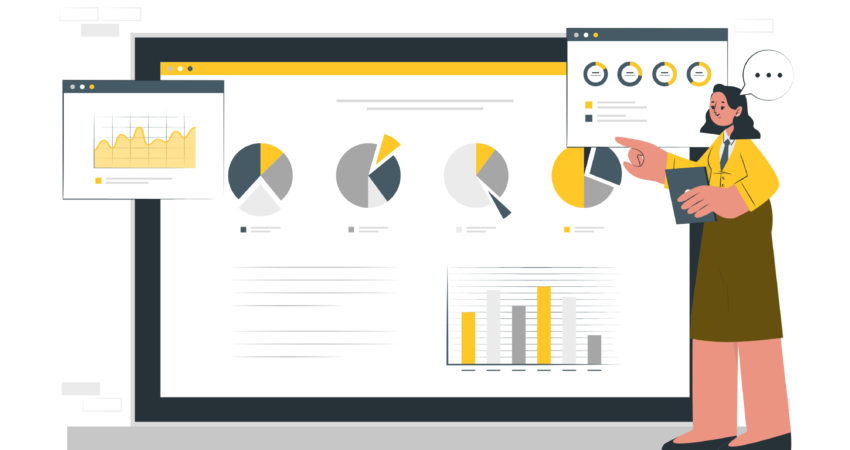
Manmeet Singh
- October 10, 2024
- 6 min read
- Marketing Automation
- Blog
I. Introduction
II. What are Custom HubSpot Reports?
III. Why Tailored Reporting is Crucial
IV. Understanding HubSpot’s Reporting Tools
V. Why Custom Reports Matter
VI. Steps to Create Custom HubSpot Reports
VII. Using HubSpot’s Custom Report Builder
VIII. Best Practices for Custom Reporting
I. Introduction
Struggling to make sense of the wealth of data in HubSpot? You’re not alone! While HubSpot offers valuable insights, sifting through all that information can feel overwhelming. This is where custom HubSpot reports come in—designed specifically to help you focus on the metrics that matter most to your business.
II. What are Custom HubSpot Reports?
Custom HubSpot reports are personalized visual representations of your data, highlighting the key performance indicators (KPIs) that drive success for your business. Unlike standard reports, they provide a clear, tailored view of the information you need to make better decisions.
III. Why Tailored Reporting is Crucial
The beauty of custom reports is that they cut through the noise, allowing you to focus on what’s truly important. Tailored insights enable smarter decision-making and more targeted strategies that can directly impact your bottom line.
IV. Understanding HubSpot’s Reporting Tools
Before diving into custom reports, it’s important to understand what HubSpot’s reporting tools have to offer.
- Overview of HubSpot Reporting Features: HubSpot’s reporting tools provide flexibility for marketers, sales teams, and customer service professionals alike. From dashboards to detailed individual reports, the platform is equipped to handle a range of analytics needs.
- Types of Reports Available: With HubSpot, you can create a variety of reports, such as traffic analytics, marketing performance, sales productivity, and customer engagement. Each type of report serves a unique purpose in informing your overall strategy.
V. Why Custom Reports Matter
In today’s data-driven world, custom reports aren’t just a nice-to-have—they’re essential for driving success.
- Aligning Reports with Business Goals: When reports are tailored to your business objectives, you’re able to track progress and refine strategies in real-time. This alignment ensures that your resources are focused on activities that directly support your growth.
- Improving Decision-Making: Tailored reports offer clarity. With the right data in hand, you can make faster, more informed decisions, and quickly adapt to market changes when necessary.
VI. Steps to Create Custom HubSpot Reports
Creating custom reports doesn’t need to be complicated. Follow these steps to get started:
- Define Your Objectives: Start by identifying what you want to achieve with your reports. Whether it’s increasing sales, boosting customer satisfaction, or improving marketing ROI, clear goals will guide your reporting process.
- Identify Key Metrics: Next, decide which metrics best align with your objectives. Whether it’s conversion rates or customer acquisition costs, focus on KPIs that provide actionable insights.
- Select the Right Data Sources: HubSpot pulls data from multiple sources like your website, email campaigns, and social media. Choose the data points that provide the most value for your report.
VII. Using HubSpot’s Custom Report Builder
Once you’ve defined your goals and gathered your data, it’s time to build your report using HubSpot’s Custom Report Builder.
Accessing the Report Builder:
Start by navigating to the “Reports” section of your HubSpot dashboard. From there, you can open the Custom Report Builder and begin creating your tailored report.
Step-by-Step Guide:
- Choose Your Report Type: HubSpot offers several types of reports, including single object reports, cross-object reports, and custom dashboards. Pick the format that suits your needs.
- Add Your Data: Bring in the data you’ve identified, whether it’s from web traffic, email performance, or other sources.
- Customize Your Report: This is where you can truly personalize your report. Adjust the layout, filters, and visualizations to ensure the report highlights the insights most valuable to your business.
- Save and Share: Once you’ve crafted your custom report, save it for easy access later. HubSpot also allows you to share your reports with your team, keeping everyone aligned on the same data.
VIII. Best Practices for Custom Reporting
To get the most out of your reports, here are some best practices to follow:
- Keep It Simple: Focus on the most important metrics, rather than overloading the report with unnecessary data. Simple, streamlined reports are easier to act upon.
- Regularly Review and Update: As your business goals change, so should your reports. Schedule regular reviews to ensure your reports remain relevant and up-to-date.
- Collaborate with Your Team: Involve your team in the reporting process. Their insights can help refine the report and provide a more well-rounded view of performance.
IX. Conclusion
Custom HubSpot reports are more than just data—they’re a window into the insights that will help your business grow. By defining your objectives, selecting the right metrics, and using HubSpot’s powerful tools, you can create tailored reports that support better decision-making and drive your business forward. Learn More at Code & Peddle.
The following posts may interest you –
What is HubSpot? Learn How Its 6 Hubs Can Fuel Your Business Expansion
FAQs
Custom HubSpot reports are personalized visual representations of your data that focus on the key performance indicators (KPIs) most relevant to your business goals. They provide insights tailored to your needs, helping you make informed decisions.
Navigate to HubSpot’s Reporting > Reports > Create Report. Choose a report type (single object, custom, funnel, attribution), select your data sources, apply filters, and visualize your metrics using charts or tables.
Default reports are pre-built templates, while custom reports give you full control to define metrics, data filters, report visuals, and segmentation based on your business goals.
By tailoring reports to your key business metrics, you gain clearer insights, which allow for faster, more informed decision-making. Custom reports help you stay focused on what drives your business growth.
Yes. HubSpot's Revenue Attribution and Custom Attribution Reports let you analyze which touchpoints and campaigns contribute to revenue—great for optimizing marketing ROI.
















